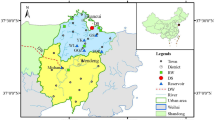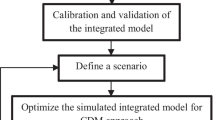Abstract
An increase in groundwater storage in aquifers in arid areas improves water security. Most desalination water production around the globe involves the private sector in the form of “build, operate, and transfer” or “build, operate, and own” agreements. Take-or-pay contracts are the most dominant contracts in the desalination industry. The water utility buys a fixed volume of water from the desalination company over a fixed period of 20 to 25 years. The contract between the two parties is established prior to building the plant to help ensure a profitable investment for all stakeholders. This regularly implies a surplus supply of desalinated water during low water demand periods. Given the absolute water scarcity in arid regions, maximizing the banking of surplus water in an aquifer is considered in this paper. For this purpose, a numerical groundwater flow simulation model, called MODFLOW, and a heuristic multiobjective optimizer, namely, NSGA-II, are coupled to optimize the injection and recovery of seasonal excess desalinated seawater in an alluvium coastal aquifer in Oman. Dual wells are considered for injection and abstraction of the water. The optimal daily abstraction and injection rates are determined by defining a multiobjective optimization framework. The four objective functions considered in this study are maximizing the total volume of desalinated water recharged into the aquifer; minimizing the groundwater losses to the sea; minimizing seawater intrusion by minimizing the maximum seasonal mean drawdown; and maximizing the total benefit from the recharge and recovery of the desalinated water. Analysis of the results revealed that we would be able to use 84% of the excess produced desalinated water (i.e., 8.4 of the 10 Mm3/year) that is currently returned to the sea. The net benefit from storage and recovery ranged between $14.77 million/year and $17.80 million/year. The increasing number of desalination plants at the global level calls for an integrated approach to bank the excess desalinated water and to improve the water security of coastal cities in arid and semiarid regions.




Similar content being viewed by others
References
Alawaji, H. (2008). Numerical modeling and analysis of micro piled square footing in silty sand over limestone rock in Riyadh. Paper presented at the The 12th International Conference of International Association for Computer Methods and Advances in Geomechanics (IACMAG) 1-6 October, 2008 Goa, India. https://citeseerx.ist.psu.edu/viewdoc/download?doi=10.1.1.384.313&rep=rep1&type=pdf
Alizadeh MR, Nikoo MR, Rakhshandehroo GR (2017) Developing a multi-objective conflict-resolution model for optimal groundwater management based on fallback bargaining models and social choice rules: a case study. Water Resour Manag 31(5):1457–1472. https://doi.org/10.1007/s11269-017-1588-7
Al-Maktoumi A, El-Rawy M, Zekri S (2016) Management options for a multipurpose coastal aquifer in Oman. Arab J Geosci 9(14):636–1962. https://doi.org/10.1007/s12665-012-2028-x
Alqahtani A, Sale T (2020) Optimizing aquifer storage and recovery wellfield operations to minimize energy consumption. J Water Resour Plan Manag 146(8):04020069
Amiresmaeili V, Jahantigh H (2017) Optimization of integrated management to use surface water and groundwater resources by using imperialist competitive algorithm and genetic algorithm (Tehran Plain). Civil Eng Jl 3(11):1068–1083. https://doi.org/10.28991/cej-030938
Amy G, Ghaffour N, Li Z, Francis L, Linares RV, Missimer T, Lattemann S (2017) Membrane-based seawater desalination: present and future prospects. Desalination 401:16–21. https://doi.org/10.1016/j.desal.2016.10.002
Bashi-Azghadi SN, Kerachian R, Bazargan-Lari MR, Solouki K (2010) Characterizing an unknown pollution source in groundwater resources systems using PSVM and PNN. Expert Syst Appl 37(10):7154–7161. https://doi.org/10.1016/j.eswa.2010.04.019
Bashi-Azghadi, S. N., Kerachian, R., Bazargan-Lari, M. R., Nikoo, M. R. (2016). Pollution source identification in groundwater systems: application of regret theory and bayesian networks. IJST-T-CIV-ENG 40(3):241–249. https://doi.org/10.1016/j.resconrec.2009.11.008
Bazargan-Lari MR, Kerachian R (2008) Developing a conflict resolution model for groundwater quantity and quality management: a case study. In: Paper presented at the World Environmental and Water Resources Congress 2008. American Society of Civil Engineers (ASCE), Honolulu. https://doi.org/10.1061/40976(316)71
Bazargan-Lari MR, Kerachian R, Mansoori A (2009) A conflict-resolution model for the conjunctive use of surface and groundwater resources that considers water-quality issues: a case study. Environ Manag 43(3):470–482. https://doi.org/10.1007/s00267-008-9191-6
Cooley H, Ajami N (2012) Key issues for seawater desalination in California: cost and financing, November 2012. Pacific Institute, California, p 48
Deb K, Pratap A, Agarwal S, Meyarivan T (2002) A fast and elitist multiobjective genetic algorithm: NSGA-II. IEEE Trans Evol Comput 6(2):182–197. https://doi.org/10.1109/4235.996017
DGSM (2012) The National Omani desalinated water standards (OS8/2012). Technical report of the Directorate General for Specifications and Measurements, Ministry of Commerce and Industry, Muscat
Dillon P, Pavelic P, Toze S, Rinck-Pfeiffer S, Martin R, Knapton A, Pidsley D (2006) Role of aquifer storage in water reuse. Desalination 188(1–3):123–134. https://doi.org/10.1016/j.desal.2005.04.109
Ebrahim GY (2013) Modeling groundwater systems: understanding and improving groundwater quantity and quality management. (PhD Thesis), Delft University of Technology, Delft
Gao L, Connor JD, Dillon P (2014) The economics of groundwater replenishment for reliable urban water supply. Water 6(6):1662–1670. https://doi.org/10.3390/w6061662
Ghaffour N, Missimer TM, Amy GL (2013) Combined desalination, water reuse, and aquifer storage and recovery to meet water supply demands in the GCC/MENA region. Desalin Water Treat 51(1–3):38–43
Harbaugh AW (2005) MODFLOW-2005, the U.S. geological survey modular groundwater model - the ground-water flow process. Techniques and methods - 6-A16, U.S. Geological Survey, Reston, p 253
Holländer HM, Mull R, Panda SN (2009) A concept for managed aquifer recharge using ASR-wells for sustainable use of groundwater resources in an alluvial coastal aquifer in eastern India. Phys Chem Earth A B C 34(4):270–278. https://doi.org/10.1016/j.pce.2008.05.001
Hosseini M, Saremi A (2018) Assessment and estimating groundwater vulnerability to pollution using a modified DRASTIC and GODS models (case study: Malayer Plain of Iran). Civil Eng Jl 4(2):433–442. https://doi.org/10.28991/cej-0309103
Kerachian R, Fallahnia M, Bazargan-Lari MR, Mansoori A, Sedghi H (2010) A fuzzy game theoretic approach for groundwater resources management: application of Rubinstein bargaining theory. Resour Conserv Recycl 54(10):673–682. https://doi.org/10.1016/j.resconrec.2009.11.008
Khan S, Mushtaq S, Hanjra MA, Schaeffer J (2008) Estimating potential costs and gains from an aquifer storage and recovery program in Australia. Agric Water Manag 95(4):477–488. https://doi.org/10.1016/j.agwat.2007.12.002
Kotagama H, Zekri S, Al Harthi R, Boughanmi H (2016) Demand function estimate for residential water in Oman. Int J Water Resour Dev 33(6):907–916. https://doi.org/10.1080/07900627.2016.1238342
Li F, Liu Y, Zhao Y, Deng X, Jiang R (2019) Regulation of shallow groundwater based on MODFLOW. Appl Geogr 110:102049. https://doi.org/10.1016/j.apgeog.2019.102049
Lokiec F, Meerovitch R (2013) Implementation of build-operate-transfer schemes: obstacles & solutions. The International Desalination Association World Congress on Desalination and Water Reuse. 2013 / Tianjin, China REF: IDAWC/TIAN13-013
Makaremi Y, Haghighi A, Ghafouri HR (2017) Optimization of pump scheduling program in water supply systems using a self-adaptive NSGA-II; a review of theory to real application. Water Resour Manag 31(4):1283–1304. https://doi.org/10.1007/s11269-017-1577-x
Missimer TM, Guo W, Maliva RG, Rosas J, Jadoon KZ (2015) Enhancement of Wadi recharge using dams coupled with aquifer storage and recovery wells. Environ Earth Sci 73(12):7723–7731. https://doi.org/10.1111/j.1745-6584.2012.00941.x
Monfared MD, Mohades A, Rezaei J (2011) Convex hull ranking algorithm for multi-objective evolutionary algorithms. Sci Iran 18(6):1435–1442. https://doi.org/10.1016/j.scient.2011.08.017
Morote ÁF, Rico AM, Moltó E (2017) Critical review of desalination in Spain: a resource for the future? Geogr Res 55(4):412–423. https://doi.org/10.1111/1745-5871.12232
Obianyo JI (2019) Effect of salinity on evaporation and the water cycle. Emerg Sci J 3(4):255–262. https://doi.org/10.28991/esj-1019-01188PAEW (2015). Public authority for electricity and water: quality water for Oman. Annual Report
PAW (2019) Diam annual report. Public Authority for Water, Muscat. https://diam.om/getattachment/8e37aa3d-b157-46b3-8b2b-75023afff72a/Annual-Report-2019. Accessed June 2020
PAEW (2015) Diam annual report. Public Authority for Electricity and Water. https://www.diam.om/getattachment/2ce0a7e7-015a-4470-b66c-0a243b59c415/%D8%A7%D9%84%D8%AA%D9%82%D8%B1%D9%8A%D8%B1-%D8%A7%D9%84%D8%B3%D9%86%D9%88%D9%8A-%D9%84%D8%B9%D8%A7%D9%85-2015
Rafipour-Langeroudi M, Kerachian R, Bazargan-Lari MR (2014) Developing operating rules for conjunctive use of surface and groundwater considering the water quality issues. KSCE J Civ Eng 18(2):454–461. https://doi.org/10.1007/s12205-014-1193-8
Reed PM, Minsker BS (2004) Striking the balance: long-term groundwater monitoring design for conflicting objectives. J Water Resour Plan Manag 130(2):140–149. https://doi.org/10.1061/(ASCE)0733-9496(2004)130:2(140)
Romero C, Rehman T (2003) Multiple criteria analysis for agricultural decisions, 2nd edition. Elsevier Science. ISBN: 9780444503435
Sauvet-Goichon B (2007) Ashkelon desalination plant – a successful challenge. Desalination 203(2007):75–81. https://doi.org/10.1016/j.desal.2006.03.525
Sepahvand R, Safavi HR, Rezaei F (2019) Multi-objective planning for conjunctive use of surface and ground water resources using genetic programming. Water Resour Manag 33(6):2123–2137. https://doi.org/10.1007/s11269-019-02229-4
Shahabi MP, Anda M, Ho G (2015) Influence of site-specific parameters on environmental impacts of desalination. Desalin Water Treat 55(9):2357–2363. https://doi.org/10.1080/19443994.2014.940653
Siegel FR (2020) Arresting/controlling saltwater contamination of coastal aquifers. In: Adaptations of coastal cities to global warming, sea level rise, climate change and endemic hazards. Springer, Cham, pp 5–9. https://doi.org/10.1007/978-3-030-22669-5_2
Song J, Yang Y, Sun X, Lin J, Wu M, Wu J, Wu J (2020) Basin-scale multi-objective simulation-optimization modeling for conjunctive use of surface water and groundwater in Northwest China. Hydrol Earth Syst Sci 24(5):2323–2341
Spellman FR (2017) Land subsidence mitigation: aquifer recharge using treated wastewater injection. CRC Press, Taylor and Francis, Boca Raton, pp 404
Sreekanth J, Datta B (2014) Stochastic and robust multi-objective optimal management of pumping from coastal aquifers under parameter uncertainty. Water Resour Manag 28(7):2005–2019. https://doi.org/10.1007/s11269-014-0591-5
Sreekanth J, Moore C, Wolf L (2016) Pareto-based efficient stochastic simulation–optimization for robust and reliable groundwater management. J Hydrol 533:180–190. https://doi.org/10.1016/j.jhydrol.2015.12.001
Tahershamsi A, Feizi A, Molaei S (2018) Modeling groundwater surface by MODFLOW math code and geostatistical method. Civil Eng Jl 4(4):812–827. https://doi.org/10.28991/cej-0309135
Triki C, Zekri S, Al-Maktoumi A, Fallahnia M (2017) An artificial intelligence approach for the stochastic management of coastal aquifers. Water Resour Manag 31(15):4925–4939. https://doi.org/10.1007/s11269-017-1786-3
Triki C, Zekri S, Al-Maktoumi A, Bazargan-Lari MR (2020) Optimal location of wells for storage and recovery of surplus desalinated water in coastal aquifers. Groundwater 58(5):831–841
Wasif MR, Hasan MM (2020) Modeling aquifer storage and recovery potential for seasonal water storage in the Flemish alluvial plains of Belgium using MODFLOW. Arab J Geosci 13(5):1–12
Wilder MO, Aguilar-Barajas I, Pineda-Pablos N, Varady RG, Megdal SB, McEvoy J, Merideth R, Zúñiga-Terán AA, Scott CA (2016) Desalination and water security in the US–Mexico border region: assessing the social, environmental and political impacts. Water Int 41(5):756–775. https://doi.org/10.1080/02508060.2016.1166416
Wolfs M, Woodroffe S (2001) Structuring and financing international BOO/BOT desalination projects. Desalination 142(2002):101–106. https://doi.org/10.3905/jsf.2002.320263
Zekri S, Ahmed M, Chaieb R, Ghaffour N (2014a) Managed aquifer recharge using quaternary-treated wastewater: an economic perspective. Int J Water Resour Dev 30(2):246–261. https://doi.org/10.1080/07900627.2013.837370
Zekri S, Al-Maktoumi AK, Abdalla OAE, Akil J, Charabi Y (2014b) Hydrogeological and economical simulations: emergency water supply for Muscat. Water Policy 16(2):340–357. https://doi.org/10.2166/wp.2013.187
Zekri S, Triki C, Al-Maktoumi A, Bazargan-Lari MR (2015) An optimization-simulation approach for groundwater abstraction under recharge uncertainty. Water Resour Manag 29(10):3681–3695. https://doi.org/10.1007/s11269-015-1023-x
Zhang H, Xu Y, Kanyerere T (2020) A review of the managed aquifer recharge: historical development, current situation and perspectives. Phys Chem Earth A B C:102887. https://doi.org/10.1016/j.pce.2020.102887
Zuurbier KG, Zaadnoordijk WJ, Stuyfzand PJ (2014) How multiple partially penetrating wells improve the freshwater recovery of coastal aquifer storage and recovery (ASR) systems: a field and modeling study. J Hydrol 509:430–441. https://doi.org/10.1016/j.jhydrol.2013.11.057
Zuurbier KG, Raat KJ, Paalman M, Oosterhof AT, Stuyfzand PJ (2017) How subsurface water technologies (SWT) can provide robust, effective, and cost-efficient solutions for freshwater management in coastal zones. Water Resour Manag 31(2):671–687. https://doi.org/10.1007/s11269-016-1294-x
Funding
The authors received support from Sultan Qaboos University’s Research Group DR\RG\17.
Author information
Authors and Affiliations
Corresponding author
Additional information
Responsible Editor: Broder J. Merkel
Rights and permissions
About this article
Cite this article
Zekri, S., Triki, C., Al-Maktoumi, A. et al. Optimization of storage and recovery of seasonal surplus desalinated water in a coastal aquifer. Arab J Geosci 14, 100 (2021). https://doi.org/10.1007/s12517-020-06340-4
Received:
Accepted:
Published:
DOI: https://doi.org/10.1007/s12517-020-06340-4




